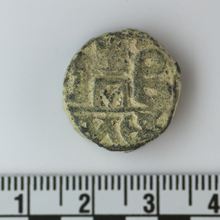Coin
MOA: University of British Columbia
3095/1007
Byzantine coin of Heraclius, 610-641. Obverse: three standing figures, facing forwards; in middle, Heraclius; to right, Heraclius Constantine, his older son; to left, Heraclonas, his younger son; each holds a globus cruciger in their right hand; above Heraclonas, there is a cross. Reverse: a cross potent above a monogram; to left, ‘I’; to right, ‘B’; in exergue, ‘AΛEΞ’. Monogram corresponds to number 27 in Sear catalogue.
-
Iconographic Meaning
The face of the emperor on coins was a symbol of his authority. On this coin both the emperor and his sons, Heraclius Constantine and Heraclonas, are depicted. The purpose of showing multiple imperial individuals on a coin was to familiarize the public with Heraclius’ potential successors, and signify their legitimacy. Heraclius and his sons hold globus crucigers, which symbolize the heavenly nature of Imperial rule. On both the obverse and reverse of the coin there is a cross, emphasizing the Christian nature of both the emperor and his empire.
-
History Of Use
“12 nummi” (denomination); DO# 197; Sear# 861. “AΛEΞ” translates to "Mint: Alexandria". This type of coin, the follis, is a large bronze coin that was introduced by the Emperor Anastasius in 498, marking a large departure from the Roman system of coinage inherited by the Byzantine Empire. It was the model for bronze Byzantine coinage for 200 years, facilitating small-scale trade and commerce. Originally, the basic follis in Constantinople was a heavy coin worth 40 nummia, with smaller follis parts equaling 20, 10, or 5 nummia. When the coin was debased and made lighter the value of it would decrease. Each provincial mints had their own divisions. In Alexandria the mint continuously produced follis parts worth 12, 6, and 3 nummia, until the province was lost to the Arab conquests. The 12 nummia coin made up the majority of the local small currency, circulating only within Egypt.
- Type of Item coin
- Culture Byzantine
- Material bronze metal
- Measurements height 0.4 cm, diameter 1.8 cm (overall)
- Previous Owner David Herman
- Received from David Herman
- Made in Alexandria
- Creation Date between 632 and 641
- Ownership Date before February 2, 2015
- Acquisition Date on February 2, 2015
- Item Classes metalwork
- Condition fair
- Accession Number 3095/1007

